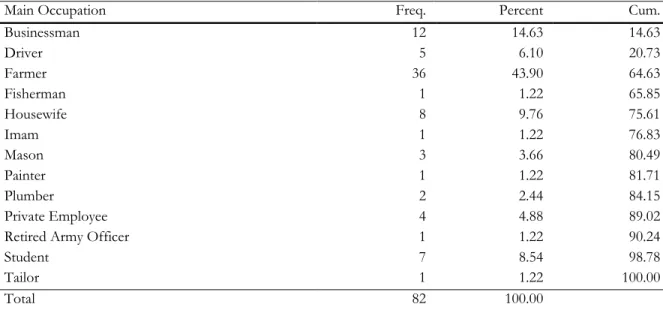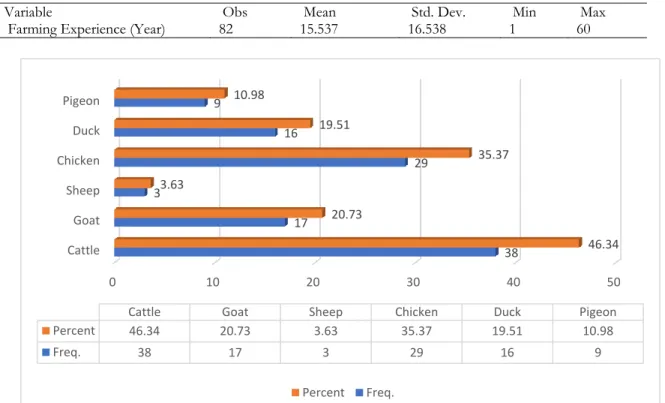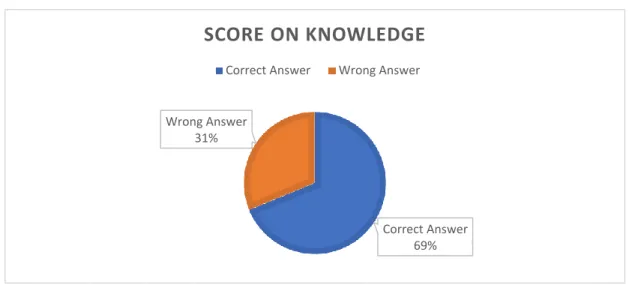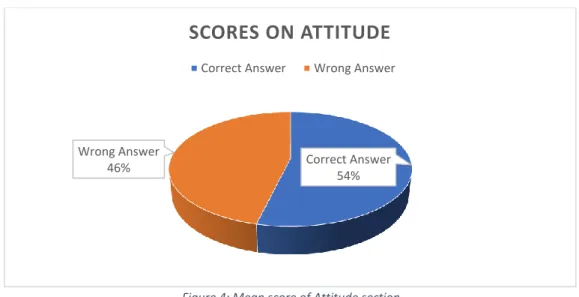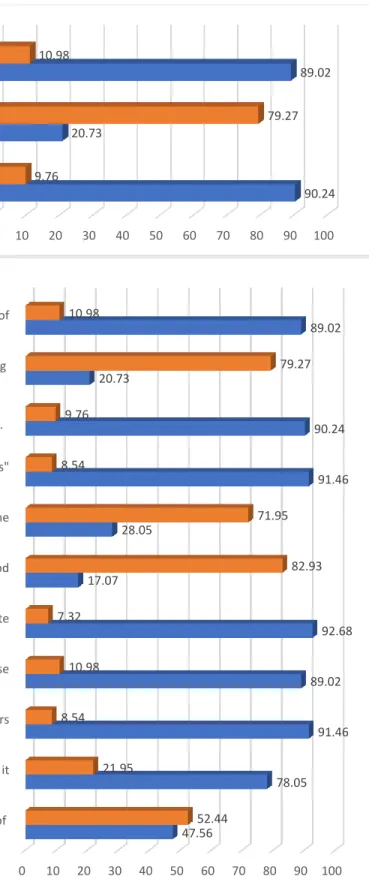Accordingly, I am solely responsible for the collection, manipulation, retention and publication of all data contained in this report. Background: A three-month survey of knowledge, attitudes and practices regarding antimicrobial use among small-scale local livestock farmers of Mirsharai, Chattogram - Bangladesh was conducted. Objectives: The aim of the study design was to determine the farmer's perspective on antimicrobial use and the conscious level to prevent antimicrobial resistance.
Materials and methods: A cross-sectional survey was conducted among small-scale local livestock farmers from February 17 to April 2022. Those who achieved more than the average score were considered to have good knowledge, positive attitudes and practices towards antimicrobial use. . The average knowledge score was 68.8%, which is not bad considering their educational background and level.
Similarly, they scored around 70% in the practice section, which was better than expected in other sections. Conclusion: According to our research, most small-scale farmers in Mirsharai, Bangladesh had little knowledge of antimicrobial use. To avoid inappropriate antibiotic use, farmers in the area should receive regular antimicrobial and AMR awareness education in the form of refresher courses/training.
Introduction
An inappropriate medication period means administering antimicrobials for a short or long period of time compared to the recommended period. A short period of drug administration cannot kill all bacteria in the body, and they can cause further infections by multiplying in the body. Due to the lack of knowledge, farmers sometimes use antimicrobials as a preventive measure that also results in AMR reducing an animal's immunity (Prestinaci et al., 2015).
Antimicrobial resistance (AMR) has emerged as one of the major global public health problems in recent decades, threatening our ability to control infectious diseases and key medical advances. Many farmers discard unused medicines, which become contaminated with soil, water, food ingredients, plants and other sources due to improper practices (Farley et al., 2018). It is crucial to assess the current situation in Bangladesh to develop and implement effective control measures against unprotected AMU.
However, current antimicrobial stewardship training, curricula, and guidelines limit the value of antimicrobial selection and. Another objective of the study was to inform current policy initiatives to control AMR and farmers' awareness.
Materials and Method
- Study area and period
- Selection of participants
- Questionnaire design and data collection
- Data Analysis
Thus, a study was conducted in Mirsharai, Bangladesh, to determine the knowledge levels, attitudes and practices of farmers regarding the use of antimicrobials in livestock. The participants were divided into four groups: cattle, goat, sheep and poultry farmers, where each farmer had to have at least three animals (cow, sheep, goat) or 10 birds (chicken, duck, pigeon). Participants were randomly selected who came to the Livestock Office and Upazila Veterinary Hospital for treatment of their animals.
Data for this cross-sectional study were collected using a standardized questionnaire that participants completed themselves. In the first part of the survey, demographic and socio-economic information was collected; in the second section, there were 16 questions about knowledge about antibiotics; in the third part there were 15 questions about attitudes; and in the fourth section, there were 16 questions about practice with case scenarios about the use of antimicrobials. The questionnaire was conducted based on some similar research in other countries and collected through google (Dyar et al., 2018; Farley et al., 2018).
The questionnaire was adapted according to the problem encountered during this testing and on the advice of supervisors. The farmers filled out the form independently, and the survey operator explained and translated each question into their native language. People who participated in the survey did so voluntarily and had the option to unsubscribe at any time.
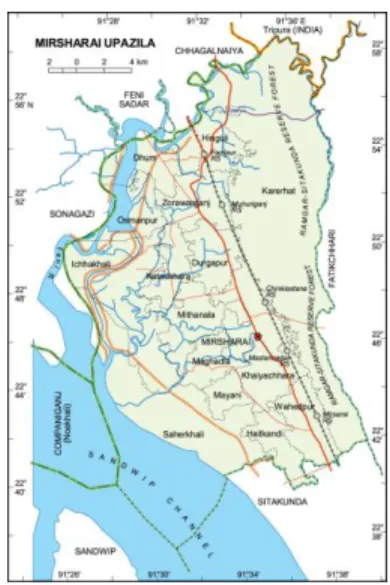
Results and Discussions
- Demographic characteristics of respondents
- Knowledge
- Attitude
- Practice
Knowledge: This section of the questionnaire was designed with 15 questions to know the status of livestock knowledge regarding antimicrobial use. Can antibiotics be used to cure infections caused by bacteria?" showed quite good knowledge (81.7% of the total respondents said "Yes"). In particular, 43% of general farmers said Yes to questions such as "Can antibiotics be used to cure infections caused by viruses?" where the expected answer was No, which was answered by 39% of farmers.
Yes" to the statement "Do you think the use of antibiotics will speed up the healing of a cold or cough?" which is an incorrect answer. Antibiotics can be obtained without a prescription at the pharmacy." showed quite good knowledge (68% of the total respondents said "No"). Do you think that using antibiotics will speed up the healing of a cold or cough?
For questions such as "Antibiotics can be used without maintenance of withdrawal" and "Antibiotics can be used in any dose and duration", 72 and 64 participants answered No, the expected answer. Again, 86.59% of all participants answered yes to the question Do you think that the excessive use of antibiotics will reduce the effectiveness of the medicine? The participants gave excellent answers to some questions such as “Antibiotic resistance is a problem in Bangladesh”, Antibiotic resistance can affect the health of your animal”, “It is necessary to know information about the correct use of antibiotics before using them”, “It is There is no need to consult a veterinarian before using antibiotics.
Participants disagreed with "At the moment there is no misuse of antibiotics", "Antibiotics are better than vaccine", "It is better to invest more in biosecurity to reduce the widespread use of antibiotics" and other statements that did not was not expected (Buckley et al., 2019; Shao et al., 2021). It is better to invest more in biosecurity to reduce the widespread use of antibiotics. It is necessary to know information about the correct use of antibiotics before administering them.
Based on questions about respondents' antibiotic procurement practices, more than 50% of respondents answered "No" to the question "Do you stop using antibiotics as soon as your animal recovers?", which was expected. For questions such as "Do you vaccinate your animal to reduce antibiotic use?", "Do you maintain regular antibiotic therapy as a preventive measure?", "Do you use antibiotics that are not prescribed?", 73, 48 and 60 participants gave the expected answer. The author found an important reason for the lower rate of attitude assessment, most of the farmers use antimicrobial drugs in their farms on the recommendation of other farmers nearby and the drug representative at the field level.
In the practice section, farmers scored the highest, which was surprising compared to the attitude score.

Strength and Limitations of this study
Conclusion
Data availability statement
Acknowledgments
Competing interests
Knowledge, attitude and practice on antibiotic use and antibiotic resistance among veterinarians and para-.
Appendix
4 It is necessary to have information about the correct use of antibiotics before applying them. 7 It is necessary to set up a training course "Rational use of antibiotics" for farmers at UVH. 8 It is better to invest more in biosafety to reduce the widespread use of antibiotics.
9 It is essential to follow the antibiotic withdrawal period before selling the livestock, to ensure safe consumption.
Biography of Author


